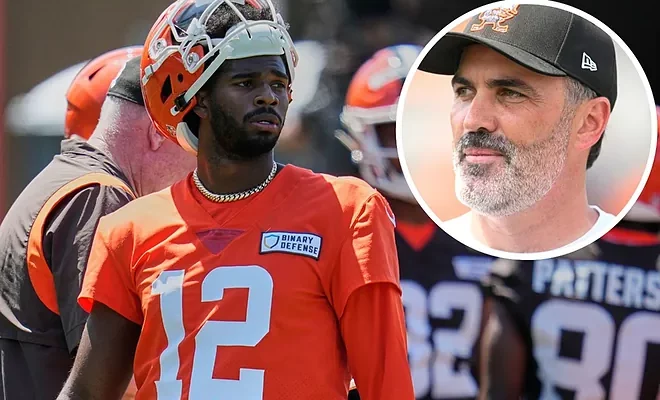The Cleveland Browns’ quarterback battle is evolving into one of the most intriguing storylines of the NFL offseason, and recent developments have added fresh complexity to the competition. Head coach Kevin Stefanski has made notable adjustments to Shedeur Sanders’ role within the team, signaling a strategic shift that could influence the trajectory of the Browns’ QB1 fight. This ongoing contest for the starting quarterback position is about far more than just individual talent — it’s a window into the Browns’ ambitions, coaching philosophy, and the future direction of their offense.
To understand the full impact of Stefanski’s decision to change Sanders’ role, it is essential to first consider the background of the Browns’ quarterback situation. Cleveland entered this offseason with uncertainty surrounding its quarterback room. Deshaun Watson, acquired in a blockbuster trade, is the presumptive starter given his elite talent, but his recovery from injury and off-field issues mean he may not be ready to immediately command the offense as the undisputed leader. This creates an opening for competition.
Among those vying for the QB1 spot alongside Watson are veteran Joshua Dobbs and the young, talented Shedeur Sanders. Sanders, son of NFL legend Deion Sanders, arrived with much fanfare due to his collegiate success, strong arm, and mobility. As a promising rookie with a unique pedigree, Sanders represents the future potential the Browns are eager to tap into. Meanwhile, Dobbs brings experience and steadiness, providing a safety net for the team.
Kevin Stefanski’s coaching style has always been about tailoring his system to maximize his players’ strengths while maintaining a balanced and efficient offense. The Browns’ offense under Stefanski is typically predicated on a strong running game, quick decision-making from the quarterback, and carefully designed play-action passes. Integrating a young quarterback like Shedeur Sanders into this framework requires patience and adaptability from the coaching staff.
Recently, Stefanski has signaled a shift in how he plans to utilize Sanders in the upcoming season. Rather than immediately thrusting him into a pure quarterback role competing directly against Watson and Dobbs for the starting job, Stefanski is experimenting with Sanders in a more hybrid role. This includes snaps in a wildcat formation or package plays designed to take advantage of Sanders’ mobility and athleticism. The idea is to leverage Sanders’ unique skill set while reducing the pressure on him to master the entire offense right away.
This approach also reflects Stefanski’s desire to manage risk carefully. Putting a rookie quarterback under center in the NFL is always a challenge, and for a team with high expectations like the Browns, mistakes can be costly. By limiting Sanders’ exposure early on but still giving him meaningful opportunities to contribute, Stefanski hopes to accelerate his development without jeopardizing the team’s competitive position.
Moreover, this role adjustment for Sanders could influence the overall quarterback competition dynamic. Instead of a straightforward battle for the starting spot, it becomes a multi-dimensional evaluation. Stefanski can assess Sanders’ readiness in real game situations, measure how well he executes in different roles, and decide if and when to increase his responsibilities. It also creates flexibility in game planning, as the Browns can use Sanders in creative ways that keep defenses off balance.
The QB1 fight also has implications beyond just the Browns’ offense. It sends a message to the roster and fanbase about the team’s commitment to building a long-term winner. Investing in Sanders by finding ways to utilize him early while developing his skills shows a blend of pragmatism and ambition. It says the Browns are not simply looking for a quick fix with Watson and Dobbs but are also thinking ahead to future seasons.
From a team chemistry perspective, Stefanski’s handling of the quarterback room will be crucial. Quarterback competitions can sometimes breed tension or division if not managed carefully. By carving out a meaningful role for Sanders, Stefanski demonstrates respect for his talent and potential, which can foster a positive environment. Meanwhile, Watson and Dobbs remain engaged and motivated by the competition, knowing their roles are secure but the starting job is still up for grabs.
Analysts have been watching this situation closely, and opinions vary on who should ultimately be the Browns’ QB1. Watson’s pedigree and upside are undeniable, but concerns linger about his ability to return to peak form. Dobbs’ reliability is attractive, especially in a team looking for stability, but he may lack the ceiling the Browns desire. Sanders, while raw, offers an exciting blend of athleticism and arm talent that could transform the offense if developed properly.
The decision to adjust Sanders’ role also fits into the broader NFL trend of utilizing quarterbacks in more versatile ways. Teams are increasingly recognizing the value of mobility and unpredictability at the quarterback position. By deploying Sanders in creative packages, the Browns align themselves with this progressive philosophy, potentially giving them an edge against defenses unprepared for such diversity.
Looking ahead, the QB1 competition in Cleveland will likely remain fluid as the preseason progresses. Stefanski and the coaching staff will continue to evaluate performance in practice, training camp, and preseason games. How well Sanders adapts to his hybrid role, how effectively Watson recovers and reintegrates, and how Dobbs performs under pressure will all shape the final decision.
Fans, too, have been divided and engaged in passionate debate over the quarterback situation. The Browns have a loyal following hungry for success and eager to see how the quarterback battle unfolds. Stefanski’s approach of balancing opportunity, development, and strategic risk will be under intense scrutiny as the season approaches.



